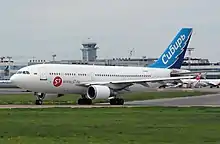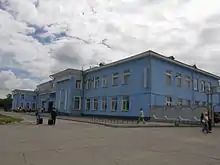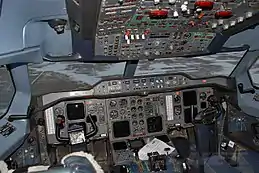S7 Airlines Flight 778
S7 Airlines Flight 778 (RU778/SBI778) was an Airbus A310-300 on a scheduled domestic passenger flight, flying from Moscow Domodedovo to Irkutsk, when it crashed upon landing at Irkutsk International Airport at 07:44 local time on 9 July 2006 (8 July, 22:44 UTC), killing 125 people. The plane overshot the runway, sliding over several hundred metres of wet runway and grass. It crashed through a concrete barricade, hit a group of private garages and burst into flames. Television pictures showed smoking ruins of the Airbus with only the tail section intact. It took two hours for local firefighters from five different fire stations to extinguish the blaze.[1]
 F-OGYP, the aircraft involved in the accident | |
| Accident | |
|---|---|
| Date | 9 July 2006 |
| Summary | Overshot the runway due to pilot error |
| Site | Irkutsk International Airport, Irkutsk, Irkutsk Oblast, Russia 52°22′48″N 104°09′55″E |
| Aircraft | |
| Aircraft type | Airbus A310-324 |
| Operator | S7 Airlines |
| IATA flight No. | RU778 |
| ICAO flight No. | SBI778 |
| Call sign | SIBERIAN 778 |
| Registration | F-OGYP |
| Flight origin | Domodedovo International Airport, Moscow, Russia |
| Destination | Irkutsk International Airport, Irkutsk, Russia |
| Occupants | 203 |
| Passengers | 195 |
| Crew | 8 |
| Fatalities | 125 |
| Injuries | 63 |
| Survivors | 78 |
In the wake of the crash, most media outlets reported that a brake failure occurred in Flight 778. However, the final report of the Russian Interstate Aviation Committee (MAK), concluded that the cause of the crash was pilot error.[2]
Background
Aircraft
Airbus said the aircraft involved in the accident was registered as F-OGYP, previously N812PA and MSN (Manufacturer Serial Number) 442. It was delivered new in June 1987 to Pan Am and later to Delta Air Lines after Pan Am's bankruptcy in 1991. The aircraft was then delivered to Aeroflot on 1 March 1995 and finally with S7 in July 2004. It had accumulated more than 52,000 flight hours in more than 10,000 flights. It was powered by two Pratt & Whitney PW4152 engines.[3][4] On one the aircraft's previous flights, the left engine's thrust reverser malfunctioned, and it was deactivated by maintenance personnel to meet the airline's Minimum Equipment List (MEL). The deactivated thrust reverser however, would later be called into question following the accident.
Passengers and crew
| Nationality | Passengers | Crew | Total |
|---|---|---|---|
| Russia | 181 | 8 | 189 |
| Germany | 3 | 0 | 2 |
| China | 3 | 0 | 2 |
| Poland | 2 | 0 | 2 |
| Belarus | 3 | 0 | 3 |
| Moldova | 2 | 0 | 2 |
| Azerbaijan | 1 | 0 | 1 |
| Total | 195 | 8 | 203 |
There were 195 passengers and 8 crew members aboard (two pilots and six flight attendants), totaling 203 people.[5]:10[6][7]
The captain was 45-year-old Sergey Gennadievich Shibanov, who had been working for the airline since June 2005. He had 10,611 flight hours, including 1,056 hours on the Airbus A310.[5]:11–20[8][9]
The first officer was 48-year-old Vladimir Grigoryevich Chernykh, who had 9,971 flight hours, with 158 of them on the Airbus A310.[5]:13–20[10]
The ITAR-Tass news agency in Russia reported that many children were among the passengers who were flying to a holiday on Lake Baikal, near Irkutsk, about 4,200 kilometres (2,600 mi; 2,300 nmi) east of Moscow. Besides Russian citizens, who were the majority of passengers, there were also 2 Polish tourists traveling to Mongolia via Irkutsk. There were 14 other non-Russians on board, 3 each from Germany, China, and Belarus, the 2 Polish tourists, 2 Moldavians, and one from Azerbaijan.[5]:10
Flight and accident

Flight 778 departed Moscow Domodedovo International Airport at 17:17 UTC. The flight was uneventful until it started its descent to Irkutsk at 22:17. At the time, the weather at Irkutsk was being affected the edge of a cyclone near Ulaanbaatar, resulting in a cold front sweeping over the area. Observers stated that the weather in Irkutsk was light precipitation with cumulonimbus clouds over the airport. Wind speed at ground level at the airport was roughly 5 m/s (11.1 MPH). If landing in Irkutsk was not possible, the flight would have to be diverted to Bratsk Airport. The plane contacted air traffic control and lined up perfectly with the runway.
After touchdown, the aircraft's spoilers were armed and the autobrake was deployed to LOW mode. Captain Shibanov, who was the pilot flying, then deployed the right engine (number 2) thrust reverser. However, at the same time, the left (number 1) engine started to generate significant forward thrust, which led to an increase in airplane speed and the onset of torque that pulled the airplane to the right.
The flight crew quickly became confused as to the nature and extent of the situation. As the aircraft speed increased, the crew tried their best to stop the plane and prevent an imminent disaster; despite their efforts, the aircraft used the entire length of the runway and overshot its end at a speed of about 180 km/h. The aircraft then smashed into a concrete barrier, where the nose collapsed and the left wing was detached from the plane, resulting in an explosion and fire that could be seen by the airport's fire station.[5] The plane then plowed into a total of 20 private garages. The fire then penetrated the cabin and destroyed the aircraft, while killing a significant number of people who had survived the initial impact, as indicated by high levels of carbon monoxide in their systems at autopsy.
Rescue operations
Air traffic controllers watching Flight 778's progress noticed that the plane was proceeding down the runway at high speed and was not slowing down. An alarm signal was issued at 22:45. The flight operation director then ordered the controller in the airport control tower to send out the initial report of the accident, and ordered the weather observer at the main observation point to compile an observation of the weather. At 22:46, the airport was closed by the Aerodrome Flight Operation Director for further takeoffs and landings.
The surviving flight attendants in the aircraft then tried to evacuate the remaining passengers on the plane. A flight attendant was suspended by her seatbelts as the floor beneath her was destroyed. When she unfastened her seatbelts, she fell to the ground and received severe burn injuries. The forward entry door was destroyed shortly after the fire. The left central door could not be opened as an intense fire was burning right below it. The right rear door and a flight attendant, who was sitting near it, were blocked by metal food containers that had fallen as a result of the airplane's collision with the barriers. The flight attendant who opened the left rear door released the emergency inflatable escape chute, thus ensuring a route for evacuating passengers. The inflatable chute opened but was damaged by sharp metal objects on the ground and lost its load-bearing capacity. Another flight attendant, helping passengers inside the cabin, was overcome by smoke and died from acute carbon monoxide poisoning. Some passengers from business class and the first compartment of the economy class evacuated through gaps that formed along the sidewall of the fuselage.
The chief of the airport fire brigade had noticed the unusual behavior of the plane as it landed and began to follow it in a fire brigade vehicle, while informing the duty lookout on the crash and rescue station tower of his decision. Thus, within seconds of the crash and explosion, the duty lookout gave the alarm at 22:44:50. After receiving the alarm, the chief of airport crash and rescue ordered to deploy airport crash and rescue teams (CRT) to the site of the accident, and the first fire truck departed the station just 10 seconds after the impact. 72 freelance CRT rescuers and 24 special-purpose vehicles were deployed. Airport CRT details arrived at the scene of the accident at 22:47.
The rescuers found most of the plane engulfed by flames, which airport firefighters tried to extinguish. Prying open the right rear cabin door (which was, initially, blocked by food containers), they found the cabin filled with thick, black smoke. They managed to save a total of 11 other people before the flames forced them to stop their rescue operation.
Victims
A total of 125 people were killed, 5 crew members and 120 passengers. The captain and the first officer died in the accident, while three out of six flight attendants were killed. 119 passengers and crews were killed due to a high intake of carbon monoxide, indicating that they survived the initial impact but subsequently perished in the fire. One flight attendant was found with a total of 85% of carboxyhemoglobin concentration inside her blood, along with her colleagues. One female passenger was killed due to severe trauma, combined with burns on her body.
The remaining 78 people (75 passengers and 3 flight attendants) survived the crash.[5]:11 Nearly 60 people were taken to a hospital, some with critical injuries, but others managed to escape with few injuries and 15 were able to continue their journeys. Some survivors said they owed their lives to the flight attendant who managed to open the emergency exit in the rear of the aircraft. The two Polish passengers, who had been in the tail section, both survived. They managed to escape the plane unassisted, one injuring a leg.[11]
Investigation
Irina Andrianova, a spokesperson for the ITAR-Tass news agency, said, "The aircraft veered off the runway on landing. It was travelling at a terrific speed."
News agencies reported Russian Transport Minister Igor Levitin as saying the pilots advised air traffic controllers they had landed successfully, but that radio contact then broke off suddenly. Speaking before flying from Moscow to Irkutsk, Levitin was also quoted as saying the runway was wet after rain.
According to Airbus, the aircraft was properly maintained. The most recent A Check, or maintenance check, on the aircraft was on 1 June 2006, Sibir said. A C Check, which involves a more thorough overhaul, was carried out 12 July 2005 in Frankfurt.[12] According to the final results of the investigation, the accident was not caused by the left engine thrust reverser's non-deployment; the thrust reverser in question was deactivated in line with Minimum Equipment List (MEL) requirements prior to the accident.
The MAK's preliminary report, issued the week of 25 September 2006, attributed the accident to pilot error, while finding that there was no problem with the engines or the aircraft.[13]

The autopilot and thrust controller were switched off by the crew at a height of 100m and could not have any effect on the landing and landing run. The couplings linking the thrust controller to the engine control linkage were uncoupled and were not connected to the linkage any more. No steering commands given by the thrust controller computer were recorded. The results of the investigation of the electronic guidance and engine control system (FADEС) testify to the efficiency of the system right up to when the airplane collided with the barriers. The airplane landed in the touchdown zone at Irkutsk airport at 22:43:40 in wheel control mode with engines running at idle. After landing, the spoilers were automatically deployed and the automatic braking system (ABS) was automatically switched on in LOW mode. 1.5 seconds after touchdown, captain Shibanov set the reverse thrust lever for the right engine to the reverse mode. The right engine correctly went into reverse thrust mode. The reverse thrust lever for the left engine was not applied.
Consequently, during the time the reverse thrust lever for the right engine was being moved forward (to reduce the reverse thrust), captain Shibanov unintentionally moved the throttle control lever for the left engine forward (increasing forward thrust) while moving the reverse thrust lever of the right engine gradually up to the stowed position and remained in that position until the time of colliding with the barriers. The throttle control lever for the left engine was in the position corresponding to the forward thrust setting of roughly 60% of its full rated takeoff thrust, and remained in that position until the flight data recorder (FDR) stopped recording. The crew apparently did not notice the left engine's increase in forward thrust and was unaware the thrust lever had been inadvertently advanced until late in the accident cycle. The flight crew only noticed an abnormality when the cockpit voice recorder (CVR) recorded the following:
07:44:18 Captain: What's wrong?
07:44:18 First officer: Speed's increasing.
07:44:19 Captain: Reverse once again!
07:44:20 First officer: We roll out. Why?
07:44:27 Captain: I don't know.
07:44:31 First officer: Oh my!
07:44:32 Captain: Shut down the engines!
07:44:34 [CHANGE IN BACKGROUND NOISE]
07:44:37 [SOUND OF FISRT IMPACT]
07:44:37 [SOUNDS OF NUMEROUS IMPACTS]
07:44:41 END OF RECORDING
— Transcript, S7 Airlines Flight 778 Cockpit Voice Recorder
The aircraft veered off the runway and hit a concrete barricade at the speed of approximately 100 kilometres per hour (62 mph).
The simultaneous congruence of the following factors contributed to the moving of the thrust control lever (TCL) that went unnoticed by the flight crew:
- presence of shakes and vibrations typical for runway at Irkutsk airport
- presence of negative acceleration during the normal run after landing with an activated right engine reverser and automatic wheel braking in LOW mode
- possibly small friction force needed to move the TCL, which makes any inadvertent movement of the throttle control lever easier
An additional possible contributing factor identified by the investigation was captain Shibanov's psychological traits. It was found that the evaluation, analysis, and interpretation of certain test data by Sibir's occupational psychologist were inadequate; as a result, the psychologist may have erred in recommending the admission of Shibanov, to the A-310 conversion training course. The captain's personality traits and type of conceptual thinking may have had a profound effect on his behavior in a stressful situation, and, particularly, may have caused disorganization in the cockpit when faced with a crisis.[5]:77–86
The MAK's final report was released in 2007 in both Russian and English. The English translation of the accident final report, on page 115, stated the following conclusion:[5]:115
The cause of Sibir A-310 F-OGYP accident was the erroneous and uncontrolled actions by the crew during rollout after landing in a configuration with one engine reverser deactivated. After touchdown, the Captain, while acting on the reverse thrust lever of the right engine, inadvertently and uncontrollably moved the throttle lever for the left engine, whose thrust reverser was deactivated, from the "idle" to the significant forward thrust position. Inadequate monitoring and call-outs of airplane speed and engine parameters by the Co-pilot made it impossible for the crew to perform the necessary actions, either by moving the left throttle back to idle or shutting down the engines. The crew had enough time to recognize the situation.
— FINAL REPORT ON THE RESULTS OF THE INVESTIGATION OF THE ACCIDENT, page 115, Interstate Aviation Committee[5]:115
See also
- Lion Air Flight 583, a 2004 Indonesian plane crash which occurred due to hydroplaning during landing in bad weather.
- TAM Airlines Flight 3054, a 2007 Brazilian plane crash which occurred due to hydroplaning and keeping forward thrust on the engine whose thrust reverser was deactivated
References
- "Reports: Brake failure may have led to crash". NBCNews.com. Associated Press. 9 July 2006.
- "У катастрофы две причины" [There are two reasons for the disaster]. Baikal Info (in Russian). 18 May 2007. Retrieved 25 June 2020.
- "S7 Airlines F-OGYP (Airbus A310 - MSN 442) (Ex N812PA)". www.airfleets.net. Airfleets aviation. Retrieved 15 October 2019.
- "F-OGYP S7 - Siberia Airlines Airbus A310-300 – cn 442". www.planespotters.net. Retrieved 15 October 2019.
- "Final accident investigation report (English translation, hosted by BEA)," (PDF). Interstate Aviation Committee. Archived (PDF) from the original on 21 June 2011. Retrieved 4 June 2019 – via Bureau of Enquiry and Analysis for Civil Aviation Safety.
- Рейс 778 Москва - Иркутск [Flight 778 Moscow - Irkutsk]. bort778.info (in Russian). 14 July 2006. Archived from the original on 18 July 2006.
- "На борту А-310 было 203 человека, сообщает компания "Сибирь"" [There were 203 people on board the A-310, Sibir company reports]. RIA Novosti (in Russian). 10 July 2006. Retrieved 25 June 2020.
- "Любовь к небу - на двоих" [Love for heaven - for two]. Baikal Info (in Russian). 6 December 2006. Retrieved 25 June 2020.
- "Катастрофа А-310-300 а/к 'Сибирь' в Иркутске (борт F-OGYP), 09 июля 2006 года" [Accident A-310-300 a/c 'Siberia' in Irkutsk (board F-OGYP), July 09, 2006]. www.airdisaster.ru (in Russian). Retrieved 25 June 2020.
- "ЧЕРНЫХ Владимир Григорьевич" [CHERNYKH Vladimir Grigorievich] (in Russian). Retrieved 25 June 2020.
- "Dwoje Polaków przeżyło katastrofę rosyjskiego samolotu" [Two Poles survived the crash of the Russian plane]. Wirtualna Polska – Wiadomości (in Polish). Archived from the original on 12 July 2006. Retrieved 9 July 2006.
- "Sibir Airbus Crashes in Russia, Killing at Least 122 (Update2)". Bloomberg. 9 July 2006.
- Dementieva, Ekaterina (2 March 2009). "Прокуратура возобновила дело об авиакатастрофе А-310 в Иркутске" [The prosecutor's office reopens the case on the A-310 plane crash in Irkutsk]. Rossiyskaya Gazeta (in Russian). Retrieved 3 January 2021.
External links
- Interstate Aviation Committee
- Investigation profile page
- Final accident investigation report (Archive) – English translation done by and hosted by the Bureau of Enquiry and Analysis for Civil Aviation Safety (BEA).
- Investigation profile page (Archive) (in Russian) – The Russian version is the version of record
- Final report (Archive) (in Russian)
- Investigation profile page
- Bureau of Enquiry and Analysis for Civil Aviation Safety
- S7 Airlines notice about the accident (Archive)
- Accident description at the Aviation Safety Network
- Multimedia